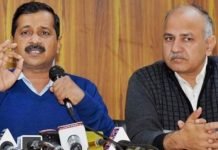
The Economic Survey tabled by the Union Minister for Finance and Corporate Affairs Nirmala Sitharaman in Parliament on Thursday portends bright prospects for economic growth. The Survey says its theme is about enabling a “shifting of gears”, “to achieve the objective of becoming USD 5 trillion economy by 2024-25, as laid down by the Prime Minister”. It says, for this “India needs to sustain a real GDP growth rate of 8%”. The Survey says that it departs from “traditional thinking by advocating a growth model for India that views economy as being either in a virtuous or a vicious cycle, and thus never in equilibrium”.
The Survey says that it “makes the case for investment, especially private investment as key driver, that drives demand, creates capacity, increases labour productivity, introduces new technology and generate jobs”. The Survey suggests that “Exports must form an integral part of the growth model because higher savings preclude domestic consumption as the driver of final demand.”
The Survey suggests that to tackle various economic challenges of demand, jobs, exports these elements are to be all complimentary and not as separate problems. The Survey states that these macro-economic elements exhibit significant complementarities and may become a part for catalyzing the “economy into a virtuous cycle”. The Survey presents “data as a public good, emphasizes legal reform, calls for policy consistency and for encouraging behavior change using principles of behavioral economics.”
The Economic Survey states the key ingredients should “include focus on policies that nourish MSMEs to create more jobs and become more productive, reduce the cost of capital and rationalize the risk-return trade-off for investments.”
The Economic Survey states that India’s economy has performed well during the last 5 years and Government has ensured that the benefits of growth and macroeconomic stability reached the bottom of the pyramid of society.
The Economic Survey states that while world output grew at 3.6% in 2014 and in 2018, India took giant strides forward to become the sixth largest economy by sustaining growth rates higher than China. The Survey stated that the “average inflation in these 5 years was less than of the inflation level of the preceding 5 years matching the lowest levels attained in the country’s post-independence history. The current account deficit (CAD) remained within manageable levels and foreign exchange reserves rose to all-time highs.”
It states that such scenario emerged from a new institutional framework of constituting of the ‘Monetary Policy Committee (MPC)’ in February 2015 with the mandate to target a headline inflation of 4 per cent with a band of two percentage points on either side. It said that “discipline was also imposed on the Gross Fiscal Deficit (GFD). The Fiscal Responsibility and Budget Management (FRBM)Act of 2003 which determines the glide path for the ratio of Gross Fiscal Deficit to GDP target of 3% got a new lease of life since 2016 and this ratio declined from 4.5% in 2013-14 to 3.4% in 2018-19. The Survey states that other macro stability indicators have similarly improved.
BENEFICIARY FOCUS AND TARGETED DELIVERY
The Survey states that the “Aadhaar Act, 2016 has enabled creation of pathways for the benefits of growth to reach the bottom of socio-economy ladder.” And the Pradhan Mantri Jan Dhan Yojana(PMJDY) and Jan Dhan, Aadhar, Mobile (JAM) trinity further secured Direct Benefit Transfers (DBT) of over 7.3 lakh crore rupees under various schemes like Mahatma Gandhi National Rural Employment Guarantee Scheme (MGNREGS), National Social Assistance Program(NSAP), Pradhan Mantri Awas Yojna-Gramin(PMAY-G), Pradhan Mantri Ujjwala Yojana(PMUY) etc,. Presently 55 central ministries through 370 cash-based schemes are transferring benefits under the DBT mechanism.
INFRASTRUCTURE
The Survey states that creation of physical infrastructure accelerated significantly during 2014-19. “Electricity finally reached everybody in India in April 2018. The construction of national highways (NH) proceeded at a rapid pace with more than 20% of the existing highway length of 1,32,000 km being constructed in the last four years alone. Scheme to extend flight connectivity to Tier 3 and Tier 4 towns was launched in 2017.
FEDERALISM
Fiscal federalism strengthened significantly when the 14th Finance Commission increased the share of States in the divisible pool of central taxes from 32% to 42%. The launch of GST in July 2017 and the GST Council experiences provides key learning for implementing cooperative federalism in several other areas such as labour and land regulation.
CORPORATE EXITS
The Insolvency and Bankruptcy Code (IBC) was operationalised in 2017 and significant number of non-performing assets were brought under its ambit. Large sums were recovered by creditors from resolution or liquidation bringing in overall improvement in the business culture of the country.
BLUE PRINT FOR GROWTH & JOBS- NEXT FIVE YEARS
“India aims to grow into USD 5 Trillion economy by 2024-25 to become the third largest economy in the world. This requires real annual growth rate in GDP of 8%.”
The Survey states that “it departs from traditional thinking by outlining growth model that views the economy being in a constant disequilibrium – a virtuous cycle or a vicious cycle”. It says “when the economy is in a virtuous cycle, investment, productivity growth, job creation, demand and exports feed into each other and enable animal spirits in the economy to thrive.” The Survey discusses the case of growth stories in China, Thailand, Indonesia and South Korea to highlight the issue of Gross Capital Formation – savings & investments contributing to GDP in these countries.
JOBS
Citing the Chinese experience, the Survey says, “when examined in the full value chain, capital investment fosters job creation as capital goods production, research and development, and supply chains also generate jobs.”
EXPORTS
The Economic Survey emphasizes on the importance of exports for economic growth of the country pointing out that India’s share in global exports is low and that it should focus on market share. The High Level Advisory Group, chaired by Dr.Surjit Bhalla, submitted its report in June 2019 on how India can enhance its exports and these need to be implemented where possible.”
EQUILIBRIUM & DISEQUILIBRIUM OF ECONOMIES
The Economic Survey Report states that “the earlier attempt to create 5-year plans, largely using the equilibrium framework, failed because it was too prescriptive for an inherently unpredictable world. Therefore, navigating this uncertain world of dis-equilibrium requires three elements: (i) a clear vision; (ii) a general strategy to achieve the vision; and (iii) the flexibility and willingness to continuously recalibrate tactics in response to unanticipated situations.
The Economic Survey Report suggests that tactics to achieve the vision of a USD 5 Trillion economy by 2024-25 would require that we need to model the different elements of the economy simultaneously in an integrated manner with assimilation tools like behavioural economics and pursuit of other new concepts for enhancing productivity and efficacy of welfare programmes.
Accordingly, the Survey says that it has dealt in separate chapters of the report, the aspects of behavioural economics, issue of continuous recalibration of policies, through data-driven evidence, to achieve the 5 trillion dollar economy.
As a part of blue print for next 5 years for achieving the objectives for the growth and also increasing jobs, the Survey suggests that “strengthening the legal system may be the best investment Indian reformers can make.”












